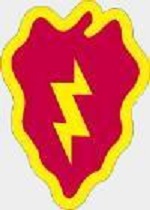Forces of Valor FOV801002B US M24 Chaffee Light Tank - 79th Tank Battalion, 25th Infantry Division, Han River, South Korea, 1950 (1:32 Scale)
"America's Pacific Division"
- Motto of the 25th Infantry Division
 The M24 Chaffee - arguably the best light tank of World War II - was a fast, lightly armored vehicle with the ability to deliver relatively large caliber direct fire thanks to its excellent 75 mm M6 gun. More than 4,000 vehicles were produced by Cadillac and Massey-Harris from 1943-45. The first vehicles reached Europe in late 1944, where they proved very effective and highly reliable. At the outset of the Korean War, however, American forces equipped with the M24 Chaffees performed poorly against the enemy's T-34/85s, and these US units were soon augmented with M26 Pershings and M46 Pattons, along with M4A3E8 Shermans armed with the long 76mm gun. The Chaffee remained in American service until 1953, at which time it was eventually replaced by the M41 Bulldog.
The M24 Chaffee - arguably the best light tank of World War II - was a fast, lightly armored vehicle with the ability to deliver relatively large caliber direct fire thanks to its excellent 75 mm M6 gun. More than 4,000 vehicles were produced by Cadillac and Massey-Harris from 1943-45. The first vehicles reached Europe in late 1944, where they proved very effective and highly reliable. At the outset of the Korean War, however, American forces equipped with the M24 Chaffees performed poorly against the enemy's T-34/85s, and these US units were soon augmented with M26 Pershings and M46 Pattons, along with M4A3E8 Shermans armed with the long 76mm gun. The Chaffee remained in American service until 1953, at which time it was eventually replaced by the M41 Bulldog.
In April 1943, the Ordnance Corps, together with Cadillac (who manufactured the M5), started work on the new project, designated Light Tank T24. The powerplant and transmission of the M5 were used together with some aspects of the T7. Efforts were made to keep the weight of the vehicle under 20 tons. The armor was extremely light and was sloped to maximize effectiveness. The turret armor was 25 mm thick with a 38 mm thick gun mantlet. The glacis plate was 25 mm thick. Side hull armor thickness varied: the frontal section was 25 mm thick but the rear third of the armor (which covered the engine compartment) was only 19 mm.
A new lightweight 75 mm gun was developed, a derivative of the gun used in the B-25H Mitchell bomber. The gun had the same ballistics as the 75 mm M3 in use by American tanks but used a thinly walled barrel and different recoil mechanism. The design featured 16 in (41 cm) tracks and torsion bar suspension, similar to the slightly earlier M18 Hellcat tank destroyer, which itself started in production in July 1943. The torsion bar system was to give a smoother ride than the vertical volute suspension used on most US armored vehicles. At the same time, the chassis was expected to be a standard used for other vehicles, such as self-propelled guns, and specialist vehicles; known together as the "Light Combat Team". It had a relatively low silhouette and a three-man turret.
On October 15th, 1943, the first pilot vehicle was delivered. The design was judged a success and a contract for 1,000 was immediately raised by the Ordnance Department. This was subsequently increased to 5,000. Production began in 1944 under the designation Light Tank M24. It was produced at two sites; from April at Cadillac and from July at Massey-Harris. By the time production was stopped in August 1945, 4,731 M24s had been produced
Pictured here is a 1:32 scale replica of a US M24 Chaffee light tank that was attached to the 79th Tank Battalion, 25th Infantry Division, then deployed to the Han River in South Korea during 1950.
Now in stock!
Dimensions:
Length: 7-inches
Width: 3-inches
Release Date: January 2024
 Historical Account: "Disarmingly Convenient" - At the conclusion of World War II the Allied nations began the process of disarmament of Axis controlled regions. Japan occupied Korea at this time and had been in control since 1910. In 1945, the decision was made to have American Marines forces oversee Japanese surrender and disarmament south of the 38th parallel and the Soviet Union would facilitate the change of power to the north. At the time there was no political motivation and seemed to be a logical and convenient plan of action. The original agreement and intent was to create a unified and independent Korea out of the post Japanese occupation era. Instead each side of the 38th parallel established its own government under the influence of the occupational country; the United States in South Korea and the Soviet Union in North Korea.
Historical Account: "Disarmingly Convenient" - At the conclusion of World War II the Allied nations began the process of disarmament of Axis controlled regions. Japan occupied Korea at this time and had been in control since 1910. In 1945, the decision was made to have American Marines forces oversee Japanese surrender and disarmament south of the 38th parallel and the Soviet Union would facilitate the change of power to the north. At the time there was no political motivation and seemed to be a logical and convenient plan of action. The original agreement and intent was to create a unified and independent Korea out of the post Japanese occupation era. Instead each side of the 38th parallel established its own government under the influence of the occupational country; the United States in South Korea and the Soviet Union in North Korea.
Both new Korean governments discredited the other and claimed to be the only legitimate political system. Tensions between the North and South escalated and each side began to petition foreign powers for resources and support. South Korea wanted weapons and supplies from President Truman and the United States government while North Korea sought help from Joseph Stalin and the Soviet Union. The United States was still war weary from the disruptive World War II campaign and refused South Korea's request for weapons and troops. North Korea convinced the Soviet Union to supply them with the weapons and support they requested. This decision coincided with the United States withdrawing the last remaining combat troops from South Korea. North Korea saw its opportunity and attacked South Korean forces at the 38th parallel on June 25th, 1950, and thus initiating the Korean War.


